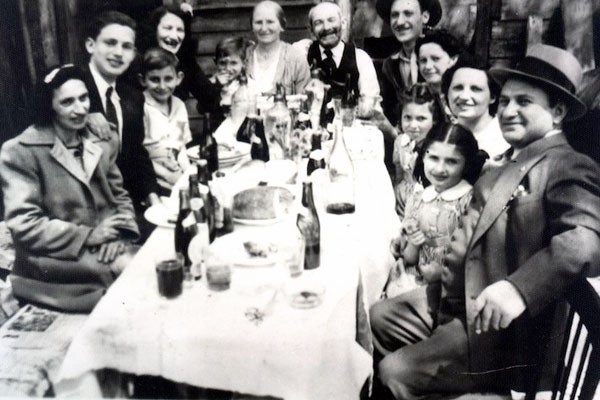
U of T in the city: students bring alive Harbord Village memories
Published: December 6, 2013
University of Toronto students from the Faculty of Information are bringing to life stories of Harbord Village in an exhibition reflecting residents’ shared experiences across time and space.
Told through themes of foodscapes, laneways and porch life, Mapping Harbord Village: Stories of a Neighbourhood uses photographs and oral histories to demonstrate eight decades of change in the neighbourhood.
The project started with The Harbord Village Residents’ Association collecting approximately 100 oral histories from residents who reminisced about what it was like to live in this part of the city from the 1920s to 1980s.
Harbord Village sits just to the west of the University's downtown campus. Predominantly Jewish in the early 20th century, today the neighbourhood is home to a highly diverse, multi-ethnic and multicultural population.
Master of Museum Studies students Brian Joe, Keely Bland, Ellen Hlozan, Melissa Smith, Hilary Walker and Adrienne Costantino, along with Professor Irina D. Mihalache, volunteered to spend three months curating an exhibition based on those interviews.
“By delving into the memories of these gathering and interactive spaces in this neighbourhood, we truly got to know it through residents’ stories. Everyone seems quite happy with the result. But for us, the exhibition was a very rewarding experience also, and a great learning opportunity,” says Joe.
The exhibition captures the diversity of the Harbord Village community through a glimpse of the spaces where the residents played, worked, learned, laughed, talked and cooked.
 One of the residents, Rafi Kosower, remembers the laneways – narrow roads between houses – being used for garbage pickup, deliveries, and even housing animals such as horses. In the 1938 photo at right, an unidentified man sells fish on Major Street (photo courtesy Tillie Karasik.)
One of the residents, Rafi Kosower, remembers the laneways – narrow roads between houses – being used for garbage pickup, deliveries, and even housing animals such as horses. In the 1938 photo at right, an unidentified man sells fish on Major Street (photo courtesy Tillie Karasik.)
“There's a lot of all sorts of things happening in lanes. People who were drinking in lanes, people who were initiating relationships, and things of that sort. There were carpenter shops with sawdust all in the lane. They were cutting through shortcuts... very mucky,” Kosower says. “Kids collected the lilacs that went along. No cars because they didn't have them. But along with snipping lilacs, they climbed the fences – the homes on Major, and Robert Street, and so on – and they went and sold these lilacs.”
Jane Adams, another resident, defined the porch area as a transitional space between the privacy of the home owners, and public space of the neighbourhood, especially when there was no air conditioning.
“There's some kind of law of physics in my mind between the porches and the front walks, so I think Major Street has the perfect proportions because I sit on my porch a lot, and people can call out and converse from the sidewalk. You know, if it was much farther they would maybe just wave or something. Or much closer, and I might feel like I was sort of sitting in the middle of the street. But Major Street has the perfect dimensions for people being able to sit on their porch, talk, chat, have a nice conversation.”
In contrast, Norman Cook explains, while the front porch became a classroom of the street, the back porch was the workspace, where chickens were plucked, fish filleted, sausages stuffed, grapes made into wine and the garden harvest canned.
“By presenting the community identity and use of neighbourhood spaces, our students have given Torontonians, and the U of T community, insights into what Harbord Villagers’ daily lives were like, right next door,” says Mihalache.
Harbord Village lies to the west of the University, with its borders being Bloor Street on the north, Spadina Avenue on the east, College Street to the south and Bathurst Street to the west.
The Harbord Village Residents’ Association is a volunteer organization of residents committed to strengthening and preserving the stability, distinctive character and quality of life of the neighbourhood. Funding from the Ontario Trillium Foundation supported the Harbord Village History Programme.
The exhibition, at The Miles Nadal Jewish Community Centre, Jacobs Lounge, 750 Spadina Avenue, runs until December 15.
Kathleen O'Brien is a writer with the Faculty of Information or iSchool at the University of Toronto.



